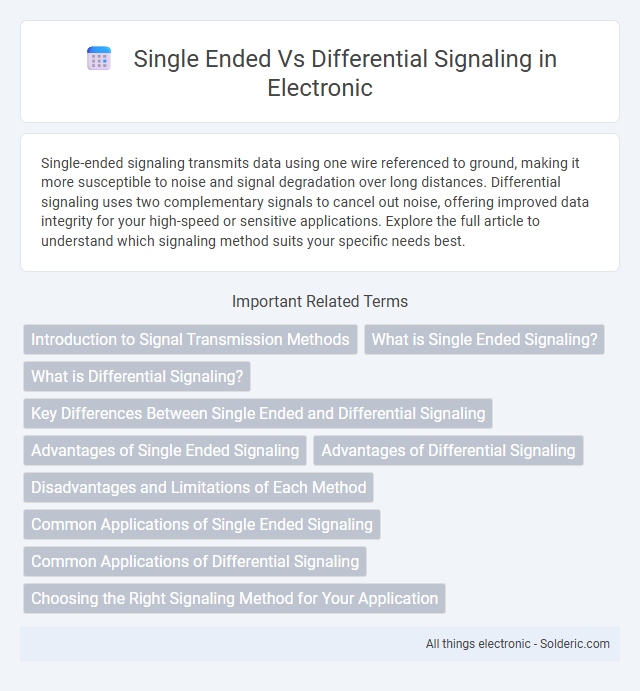Single-ended signaling transmits data using one wire referenced to ground, making it more susceptible to noise and signal degradation over long distances. Differential signaling uses two complementary signals to cancel out noise, offering improved data integrity for your high-speed or sensitive applications. Explore the full article to understand which signaling method suits your specific needs best.
Comparison Table
| Feature | Single Ended Signaling | Differential Signaling |
|---|---|---|
| Signal Lines | One signal line plus ground | Two complementary signal lines |
| Noise Immunity | Low; susceptible to external noise | High; rejects common-mode noise |
| Signal Integrity | Degrades over longer distances | Maintains integrity over long distances |
| Data Rate | Lower, limited by noise and interference | Higher, supports faster data transfer |
| Power Consumption | Typically lower | Generally higher due to two lines |
| Complexity and Cost | Simpler, less expensive | More complex, higher cost |
| Common Applications | Analog audio, simple digital signals | High-speed digital communications, USB, Ethernet |
Introduction to Signal Transmission Methods
Single-ended signaling transmits electrical signals using one wire referenced to a common ground, making it susceptible to noise and interference. Differential signaling employs two complementary signals transmitted over paired wires, enhancing noise immunity and signal integrity in high-speed data communication. This method is widely preferred for critical applications requiring reliable and accurate data transmission across longer distances.
What is Single Ended Signaling?
Single-ended signaling transmits data using a single conductor and a reference ground, making it simpler but more susceptible to noise and interference over longer distances. This method is commonly used in basic audio and digital communication systems where cost and complexity are minimized. Understanding single-ended signaling helps you evaluate appropriate applications and limitations compared to more robust alternatives like differential signaling.
What is Differential Signaling?
Differential signaling uses two complementary voltage signals to transmit data, significantly reducing electromagnetic interference (EMI) and crosstalk compared to single-ended signaling. This method improves signal integrity by measuring the voltage difference between the two lines, making it highly effective for high-speed and long-distance communications. Your devices benefit from enhanced noise immunity and reduced signal degradation when using differential signaling.
Key Differences Between Single Ended and Differential Signaling
Single ended signaling transmits data using one wire referenced to ground, making it simpler but more prone to noise and signal degradation over long distances. Differential signaling uses two wires carrying opposite signals, enhancing noise immunity and allowing for higher data integrity and longer transmission ranges. Your choice between single ended and differential signaling depends on factors like noise environment, cable length, and required signal quality.
Advantages of Single Ended Signaling
Single-ended signaling offers simplicity and cost-effectiveness by using a single wire and a common ground, reducing the need for complex circuitry and cabling. It consumes less power compared to differential signaling, making it ideal for low-speed and short-distance communication in consumer electronics. The straightforward design allows easier troubleshooting and integration in systems where noise interference is minimal.
Advantages of Differential Signaling
Differential signaling offers superior noise immunity by transmitting two complementary signals, allowing common-mode noise to be effectively canceled at the receiver. It enhances signal integrity over long distances and in electrically noisy environments, ensuring higher data reliability and reduced bit error rates. This method also supports higher data rates and lower electromagnetic interference (EMI) emissions compared to single-ended signaling.
Disadvantages and Limitations of Each Method
Single-ended signaling suffers from susceptibility to electromagnetic interference (EMI) and crosstalk, which can degrade signal integrity in noisy environments. It also experiences limited noise immunity and reduced maximum cable length due to ground potential differences. Differential signaling, while more robust against noise and capable of longer transmission distances, requires more complex circuitry, higher cost, and increased power consumption due to the use of two complementary signals.
Common Applications of Single Ended Signaling
Single ended signaling is commonly used in low-speed data communication systems such as UART, I2C, and SPI interfaces in embedded systems. It is favored in consumer electronics for audio and video signal transmission due to its simplicity and cost-effectiveness. Single ended signaling is also prevalent in analog sensor inputs and basic microcontroller communication where noise immunity requirements are minimal.
Common Applications of Differential Signaling
Differential signaling is commonly used in high-speed data transmission applications such as Ethernet, USB, HDMI, and PCIe interfaces due to its superior noise immunity and reduced electromagnetic interference. It is also favored in industrial automation, automotive systems, and audio equipment where signal integrity must be maintained over long cable runs or in electrically noisy environments. You benefit from enhanced signal quality and reliability by choosing differential signaling in these critical communication systems.
Choosing the Right Signaling Method for Your Application
Selecting the appropriate signaling method depends on factors such as noise immunity, signal integrity, and cable length. Single-ended signaling suits short distances and low-noise environments, using a single conductor referenced to ground, while differential signaling involves two complementary signals that enhance noise rejection and are preferable for long-distance or high-speed data transmission. Evaluating system requirements like electromagnetic interference (EMI) tolerance and data rate ensures optimal performance by choosing between single-ended and differential signaling.
Single Ended vs Differential Signaling Infographic

 solderic.com
solderic.com